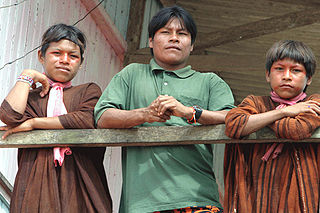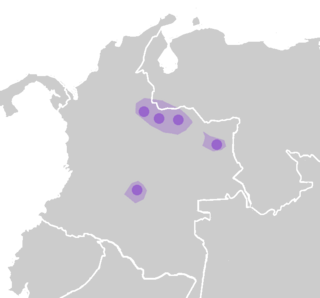
The Chinantec or Chinantecan languages constitute a branch of the Oto-Manguean family. Though traditionally considered a single language, Ethnologue lists 14 partially mutually unintelligible varieties of Chinantec. The languages are spoken by the indigenous Chinantec people who live in Oaxaca and Veracruz, Mexico, especially in the districts of Cuicatlán, Ixtlán de Juárez, Tuxtepec and Choapan, and in Staten Island, New York.

Macro-Arawakan is a proposed language family of South America and the Caribbean centered on the Arawakan languages. Sometimes, the proposal is called Arawakan, and the central family is called Maipurean.

Je–Tupi–Carib is a proposed language family composed of the Macro-Je, Tupian and Cariban languages of South America. Aryon Rodrigues (2000) based this proposal on shared morphological patterns. In an earlier proposal, Rodrigues (1985) had also proposed a Tupí-Cariban language family.

The Asháninka or Asháninca are an indigenous people living in the rainforests of Peru and in the State of Acre, Brazil. Their ancestral lands are in the forests of Junín, Pasco, Huánuco and part of Ucayali in Peru.

The Machiguenga are an indigenous people who live in the high jungle, or montaña, area on the eastern slopes of the Andes and in the Amazon Basin jungle regions of southeastern Peru. Their population in 2020 amounted to about 18,000. Formerly they were hunter-gatherer but today the majority are sedentary swidden cultivators. The main crops grown are manioc, maize, and bananas, but today commercial crops such as coffee and cacao are increasingly important. Their main source of protein used to be peccary and monkeys but today fish has become more important as game animals have become increasingly scarce as a consequence of the encroachment from highland immigrants to the area and the exploitation of the Camisea gas finds. The Machiguenga people have a preference for self-sufficiency when it comes to cultivating essential crops, made possible by their generous land allocation per capita, and the lack of conflict in their area.

Arawakan, also known as Maipurean, is a language family that developed among ancient indigenous peoples in South America. Branches migrated to Central America and the Greater Antilles and Smaller Antilles in the Caribbean and the Atlantic, including what is now the Bahamas. Almost all present-day South American countries are known to have been home to speakers of Arawakan languages, the exceptions being Ecuador, Uruguay, and Chile. Maipurean may be related to other language families in a hypothetical Macro-Arawakan stock.

The Zapotec languages are a group of around 50 closely related indigenous Mesoamerican languages that constitute a main branch of the Oto-Manguean language family and are spoken by the Zapotec people from the southwestern-central highlands of Mexico. A 2020 census reports nearly half a million speakers, with the majority inhabiting the state of Oaxaca. Zapotec-speaking communities are also found in the neighboring states of Puebla, Veracruz, and Guerrero. Labor migration has also brought a number of native Zapotec speakers to the United States, particularly in California and New Jersey. Most Zapotec-speaking communities are highly bilingual in Spanish.

Juan Santos Atahualpa Apu-Inca Huayna Capac was the messianic leader of a successful indigenous rebellion in the Amazon Basin and Andean foothills against the Viceroyalty of Peru in the Spanish Empire. The Juan Santos Rebellion began in 1742 in the Gran Pajonal among the Asháninka people. The indigenous people expelled Roman Catholic missionaries and destroyed or forced the evacuation of 23 missions, many of them defended, in the central jungle area of Peru. Several Spanish military expeditions tried to suppress the rebellion but failed or were defeated. In 1752, Santos attempted to expand his rebellion into the Andes and gain the support of the highland people. He captured the town of Andamarca and held it for three days before withdrawing to the jungle. Santos disappeared from the historical record after 1752.

Guajiboan is a language family spoken in the Orinoco River region in eastern Colombia and southwestern Venezuela, a savanna region known as the Llanos.

Asháninka is an Arawakan language spoken by the Asháninka people of Peru and Acre, Brazil. It is largely spoken in the Satipo Province located in the amazon forest. While there are low literacy rates in Asháninka, language use is vibrant among the Asháninka.
Ashéninka is the name that some varieties included in the Ashéninka-Asháninka dialect complex have traditionally received. These varieties belong to the Campan branch of the Arawak family. Ethnologue distinguishes seven languages throughout the whole complex, while Pedrós proposes a division in three languages based on the principle of mutual intelligibility. The varieties included in Ashéninka and Northern Ashé-Ashá have traditionally been called Ashéninka. Glottolog reflects Pedrós’ proposal, although considering the languages proposed by him as groupings of the languages that the Ethnologue distinguishes.
Huasteca Nahuatl is a Nahuan language spoken by over a million people in the region of La Huasteca in Mexico, centered in the states of Hidalgo (Eastern) and San Luis Potosí (Western).

Carlos Fermín Fitzcarrald López was a Peruvian rubber baron. He was born in San Luis, Ancash, in a province that was later named after him. In the early 1890s, Fitzcarrald discovered the Isthmus of Fitzcarrald, which was a portage route from the Ucayali River into the Madre de Dios River basin. Fitzcarrald became known as the "King of Caucho" due to his success during the rubber boom. His enterprise exploited and enslaved Asháninka, Mashco-Piro, Harákmbut, Shipibo-Conibo and other native groups, who were then dedicated to the extraction of rubber. In 1897, Fitzcarrald, along with his Bolivian business partner Antonio Vaca Díez, drowned in an accident on the Urubamba River.
Peru ratified the 2000 UN TIP Protocol in January 2002.
Nomatsiguenga (Matsigenka) is an Arawakan language of Peru. It is close enough to Machiguenga to sometimes be considered dialects of a single language, especially given that both are spoken by the Machiguenga people. Most speakers are monolingual.
Nanti is an Arawakan language spoken by approximately 250 people in southeastern Peruvian Amazonia, principally in a number of small communities located near the headwaters of the Camisea and Timpía Rivers. It belongs to the Kampan branch of the Arawak family, and is most closely related to Matsigenka, with which it is partially mutually intelligible.
The Cerro de la Sal or Cerro de Sal, is located in Villa Rica District of Oxapampa Province in Pasco Department, Peru. The Cerro de la Sal was an important source of salt for the pre-Columbian indigenous people of the Amazon Basin in Peru. Because of the seasonal concentration at the mountain by indigenous people (Indians), especially the Asháninka and Yanesha (Amuesha), Spanish missionaries, settlers, and soldiers were attracted to the Cerro de la Sal as early as 1635. Several attempts by Franciscan missionaries to establish Roman Catholic missions in the area were thwarted by uprisings of the indigenous people. In the late 19th century the Peruvian government established a foothold leading to the settlement of Europeans and Andean peoples in the area.

The Gran Pajonal is an isolated interfluvial plateau in the Amazon Basin of Peru. It is located in the departments of Ucayali, Pasco and Junín. The plateau is inhabited by the Asháninka or Ashéninka people along with late-twentieth century immigrants largely from the Andes mountains of Peru. In the 1730s, Roman Catholic Franciscan missionaries established missions in the Gran Pajonal, but the missions were destroyed in the 1740s by the Ashaninka under the leadership of Juan Santos Atahualpa.

The Juan Santos Rebellion was an Indigenous uprising against the Spanish Empire in Colonial Peru that took place from 1742 to 1752. The rebellion was led by and named after Juan Santos Atahualpa, an Indigenous man from Cusco. Juan Santos had worked as an assistant to Spanish Franciscan missionaries in the Yungas region, and over time he became outraged at the abuses committed by the Spanish missionaries against the local Asháninka tribe, which led him to plan a rebellion against the Spaniards. Juan Santos declared himself to be the reincarnation of Inca emperor Atahualpa, and he managed to gather a large following among the Asháninkas.












